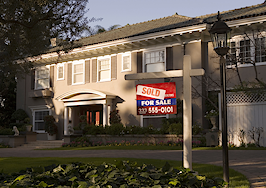The prospect of more severe Fed tightening has spooked bond market investors, pushing rates for conforming 30-year fixed-rate mortgages above 4 percent for the first time since December 2019, according to a daily index of rate lock data compiled by Optimal Blue.
The Optimal Blue Mortgage Market Indices also show that while first-time buyers seeking FHA-backed mortgages can expect to pay even higher rates, lenders are offering discounted rates on jumbo loans that are too big for purchase by Fannie Mae and Freddie Mac.
Mortgage rates break 4 percent threshold
Optimal Blue’s lock data shows rates on conforming 30-year fixed-rate mortgages eligible for purchase by Fannie and Freddie averaged 4.071 percent on Thursday, while lenders were offering jumbo loan borrowers rates averaging 3.696 percent.
FHA borrowers, who are often first-time homebuyers with lower credit scores and little savings for down payments, paid the highest rates — 4.122 percent, on average.
According to Optimal Blue’s data, rates on the workhorse 30-year conforming loan hit an all-time low of 2.77 percent on Dec. 31, 2020 when the Federal Reserve was buying $120 billion in Treasurys and mortgage-backed securities every month to support the economy during the pandemic.
The Fed announced in November that it would begin tapering those purchases — a process that it will complete this month, setting the stage for policymakers to begin raising short-term interest rates in March.
Fed policymakers have been telegraphing their intention to raise the short-term federal funds rate six times this year, one quarter of a percentage point at a time.
But bond investors were startled Thursday by a U.S. Department of Labor report showing the consumer price index rose 7.5 percent in January, the largest annual increase since 1982.
After that report came out, St. Louis Fed Chair James Bullard fueled investor concerns, telling Bloomberg News that he would support raising the federal funds rate by a full percentage point during the first half of the year — a rapid increase that which would entail implementing the first half-point rate hike since 2000.
“I’d like to see 100 basis points in the bag by July 1,” Bullard told Bloomberg. “I was already more hawkish but I have pulled up dramatically what I think” the Federal Open Market committee should do to fight inflation.
Bullard also said he wants to begin shrinking the Fed’s nearly $9 trillion balance sheet during the second quarter. Minutes from the committee’s December meeting showed almost all members agree with Bullard that “it would likely be appropriate to initiate balance sheet runoff at some point after the first increase in the target range for the federal funds rate.”
Thursday’s inflation numbers and Bullard’s reaction to them sent 10-year Treasurys yields — a barometer for mortgage rates — climbing 10 basis points Thursday, breaching the 2 percent threshold for the first time since the summer of 2019.
Impact of rising rates on home prices and sales
Fannie Mae’s latest National Housing Survey showed the percentage of Americans who think it’s a good time to buy a home fell to an all-time low in January, with rising home prices and interest rates making homes unaffordable for many would-be homebuyers.
In their most recent forecast, Fannie Mae economists predicted that many homebuyers will be priced out of the market this year, and that sales of existing homes will fall by 3.2 percent, to 5.945 million. That would still be the second-best year since 2006, and sales of new homes are projected to grow by 14.9 percent, to 885,000, as builders start putting homes now under construction on the market.
Fannie Mae economists expect that home price appreciation will remain strong but decelerate in 2022, as worsening affordability will slow home price growth from a peak of 18.5 percent during the third quarter of 2021, to 7.6 percent by the end of the year.
That forecast assumed that rates on 30-year fixed-rate loans would not rise above 3.5 percent this year — an assumption that now looks out of date.
But rising rates could also “supercharge” the housing market ahead of the spring homebuying season, as the fear of missing out on low rates could get buyers off the fence, according to a recent analysis by Mark Fleming, chief economist for First American Financial Corp.
First American’s analysis of the potential impact of rising rates shows that with rates at 4 percent, homebuyers already have $52,000 less house buying power than they did in November.
How interest rates impact homebuying power

With mortgage rates at 4 percent, a homebuyer who could qualify to buy a $475,180 home in November can now only afford a $423,262 home. Source: First American data and analytics.
Similarly, a recent analysis by Redfin estimates that when mortgage rates were at their all-time low of 2.71 percent, a buyer who could afford to make a $2,000 monthly payment (including mortgage, taxes and insurance) could afford homes priced up to $425,250. With rates at 4.1 percent, the same buyer could not qualify for houses priced above $375,750 — a difference of nearly $50,000.
“With home prices and mortgage rates increasing, we might start to see buyers trading space for smaller homes that are closer to amenities,” said Kristin Lopez, a Redfin agent in Boise, Idaho. “So instead of purchasing large homes in the suburbs, many buyers may ‘settle’ for a smaller home or even a townhome closer to the city and then buy a bigger house later if they need more room.”
Jumbo loans available at lower rates
Optimal Blue’s lock data shows that while rates on conforming 30-year fixed-rate mortgages eligible for purchase by Fannie and Freddie exceeded 4 percent, jumbo loans were available at better rates.
Historically, that’s not always been the case. During June, July and August 2020, Optimal Blue data shows rates on jumbo mortgages averaged 3.29 percent, 26 basis points higher than the 3.03 percent average rate for conforming loans.
Since then, the “spread” between jumbo and conforming loans has flipped, and has been growing wider this year. During January, rates on jumbo mortgages averaged 3.39 percent, 27 basis points lower than the 3.66 percent rate for conforming loans.
Thanks to rising home prices, Fannie and Freddie are now allowed to back single-family mortgages of up to nearly $1 million in some high cost markets. Fannie and Freddie’s 2022 baseline conforming loan limit was increased to $647,200 in most areas of the country, with a ceiling for one-unit properties in high cost areas of $970,800.
But Fannie and Freddie’s federal regulator is requiring them to implement new fees on second homes and high balance loans exceeding the aseline conforming limit. That means a growing number of homebuyers may find that it’s cheaper to do business with private lenders who fund loans without Fannie and Freddie’s backing.
Mortgage rates by credit score and LTV
Mortgage lenders are becoming more willing to loan to “non-prime” borrowers, with home loans provided to subprime and near-prime borrowers up 17.6 percent during the third quarter of 2021, according to TransUnion.
Since rates will vary by lender and the borrower’s credit score and loan-to-value (LTV) ratio, it’s smart to get quotes from multiple lenders.
While non-prime borrowers can expect to pay higher rates, Optimal Blue data shows that borrowers with excellent credit scores can still obtain rates below 4 percent on conforming loans when making a down payment of at least 20 percent to keep the loan-to-value ratio below 80 percent.
Get Inman’s Extra Credit Newsletter delivered right to your inbox. A weekly roundup of all the biggest news in the world of mortgages and closings delivered every Wednesday. Click here to subscribe.












